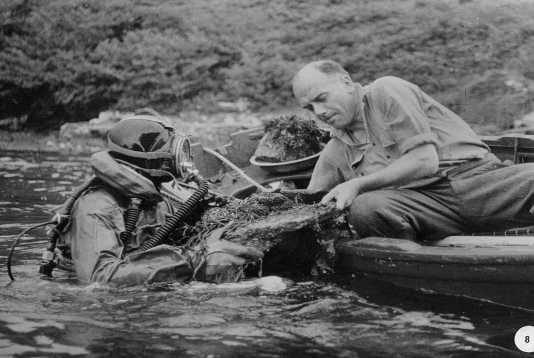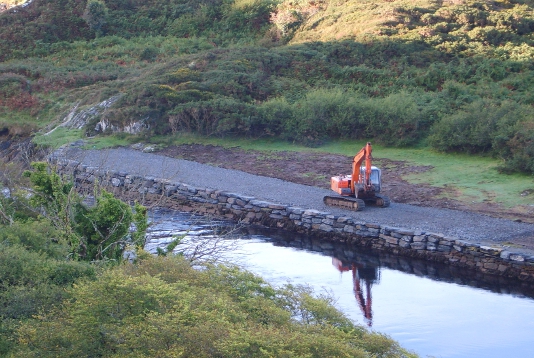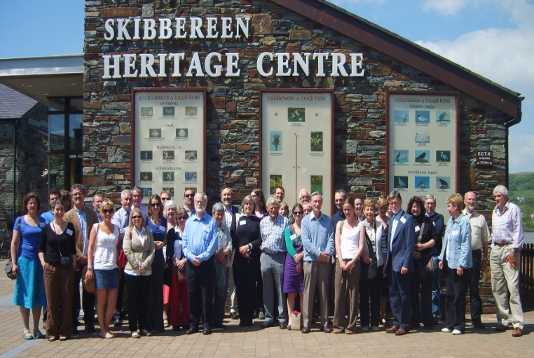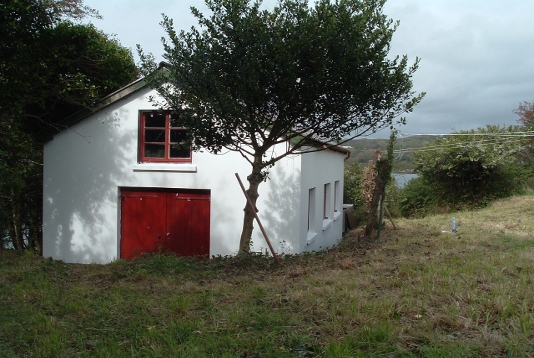Lough Hyne
Explore This Page
Location Background
Lough Hyne is a semi-enclosed marine lake situated 3 miles west of Skibereen and some 50 miles from Cork City in Southwest Ireland. It measures just 0.8 km by 0.6 km and it is believed that the Lough was a freshwater lake up to 4000 years ago, when a rise in sea levels joined it with the sea. It is now a highly sheltered, seawater basin connected to the North Atlantic Ocean via a narrow inlet called Barloge Creek.
R.McAllen.jpg)
Lough Hyne as viewed from the summit of Knockomagh Hill. Photo: R. McAllen
At the northern end of Barloge Creek, there is a very narrow, shallow constriction known as the “Rapids”. The “Rapids” are no deeper than 5m at high tide and this highly restrictive sill leads to an asymmetrical tide with water flooding in for 4 hours and ebbing for 8.5 hours. Water flow within the Rapids can reach 3ms -1.
Lough Hyne was designated Europe’s first statutory Marine Nature Reserve in 1981 in order to protect the rich biodiversity that occurs within its depths. The Lough supports many different marine habitats and environmental conditions (cliffs, beaches, boulders and saltmarshes in water movement ranging from still to very fast - 0.05 ms -1 to 3ms -1). The deepest part of the Lough is some 52m in the Western Trough. Whilst the rich fauna and flora of Lough Hyne have been protected for over 30 years (30th anniversary on June 3rd 2011), scientific research has been ongoing for well over 100 years.

The “Rapids” situated at the southeast entrance to the Lough leading into Barloge Creek. University College Cork’s Renouf lab is seen next to the rapids. Photo: R. McAllen
History of Scientific Research at Lough Hyne

Photo: The wooden research huts alongside the Rapids – circa 1950.
The first recorded biological study at Lough Hyne occurred in 1886 when the Rev. William Spottswood Green made the first recording of the Purple Sea-Urchin Paracentrotus lividus - a species that has become one of the most studied organisms in the Lough and is currently the subject of a long-running population survey by Dr Anne Crook (University of Reading).
The start of more regular biological studies began in 1923, when Prof Louis Renouf from University College Cork began visiting the Lough. In 1928 an ex-army hut was assembled beside the Rapids to act as the first on-site research laboratory. Although being destroyed by tidal surges and reassembled in 1942 and again in 1962, the hut acted as the starting point for regular marine research and led to the construction of two further wooden huts in the 1930’s which attracted the attention of overseas workers.
Among the first visitors to the Lough in the 1930’s were J.A. Kitching and F.J. Ebling. They were regular visitors until the onset of WWII, but the returned in 1946 to begin regular summertime work until 1986. Kitching and Ebling’s team would consist largely of undergraduates camping for the summer in large tents on the southern shore of Lough Hyne.

Photo: Jack Kitching and John Ebling’s research camp at Glanafeen. – circa 1950.
After visiting Lough Hyne for a number of years Prof. Kitching erected a further two laboratories. A small concrete building on the east side of the Rapids was completed in 1954 and was known as the Dromadoon laboratory. The other was built at Glanafeen on the southern shore of Lough Hyne between 1952 and 1957. This led to the influx of visiting marine biologists especially from the U.K. Unfortunately during the 1960’s the condition of the labs owned by University College Cork deteriorated and were largely unused after 1967. There were few Irish biologists working at the Lough at this time and the remaining buildings beside the Rapids totally collapsed in 1976.

Photo: Jack Kitching (Diving) and Jock Sloane collecting samples from near the Rapids.
However, in 1975 Dan Minchin from the Irish Department of Agriculture and Fisheries took an interest in the Lough to look at the biology of scallops and their predators using a caravan on the north shore as his lab. This renewed interest led to University College Cork staff and students beginning to conduct research at the Lough once more and in 1987, a new two level building known as the Renouf lab was opened alongside the Rapids. At the same time, Prof. Kitching donated his two labs at Glanafeen and Dromadoon to UCC. The Glanafeen lab was subsequently renamed the Kitching lab in recognition of Prof. Kitching’s services to biological research at Lough Hyne. In December 2001, the Dromadoon laboratory was renamed the John Bohane Laboratory in recognition of the role of John Bohane as Caretaker of Lough Hyne for over 60 years.

Photo: Rapids erosion June 2006. (Photo: R.McAllen)
In 2006 after 50 years of concern, work to rebuild the collapsed western wall of the Rapids took place. Current speeds through the Rapids can reach 3 m/s and it had a dramatic effect on the Famine wall on the Rapids western side built in 1852. The rate of erosion and collapse of the Rapids wall has been a concern to Lough Hyne users for over 50 years and in recent times there had been an almost total collapse of the wall and subsequent large scale erosion of the land near one of UCC’s three on-site laboratories, the Renouf lab. With funding of €55,000 from a Heritage Council Biodiversity Fund 2006 award to Dr Rob McAllen as well as significant additional funding from University College Cork, Cork County Council and the National Parks and Wildlife Service (NPWS), rebuilding work of the Rapids wall and reclamation of the eroded land took place during September and October 2006. The Lough Hyne Rapids is a piece of Irish Marine Heritage and is a very well-known and well-studied marine biological research area as well as a major tourist area. By succeeding in rebuilding the Rapids bordering wall structure and the surrounding area, UCC, The Heritage Council, NPWS and Cork County Council have played a major role in securing the future of Lough Hyne and its inhabitants for generations to come.

Photo: Rapids after construction November 2006 (Photo: R.McAllen)
On June 3rd 2011, Lough Hyne celebrated the 30th anniversary on its designation as a Marine Reserve. To acknowledge this occasion, a 2 day conference and celebration took place at the West Cork Hotel, Skibbereen and at the Lough itself. 65 delegates attended the conference which had 15 presentations from past and pesent researchers.

Photo: Some of the delegates attending the Lough Hyne @30 conference 3rd June 2011. (Photo: R.McAllen)
Research at Lough Hyne
Current PhD students and recent completed PhD studies
Valerio Micaroni: Effects of anthropogenic stressors on temperate subtidal benthic communities (2018-2021)
Coastal ecosystems are among the most productive biomes on the planet, but also among the most vulnerable. A large variety of anthropogenic impacts are threatening their integrity, and consequently, their capability to provide goods and services. Between these, eutrophication is considered one of the main stressors. Lough Hyne is a fully marine sea lough located in the west Cork, designated as Europe's first statutory Marine Nature Reserve in 1981 for its extraordinary biodiversity. Unfortunately, during the last decade the benthic assemblages of the lough, in particular sponges, experienced drastic changes, probably related to eutrophication-driven processes. The aims of my research are to investigate the effects of anthropogenic stressors on temperate subtidal benthic assemblages, especially on sponges, through the analysis of the case study Lough Hyne. In particular, the project aims to characterize the changes occurred, investigate the possible causes, assess the trophic consequences and explore the potential for restoration
---------------------------------------------
Mary Catherine Gallagher: The effects of an invasive species on the structure of a native ecosystem (completed 2017)
My PhD research was focused on the invasive barnacle species Austrominius modestus. This species has been present in Europe for over seventy years, but recent increases in the abundance of this species at some locations have been linked to climate change, with some researchers describing A. modetsus as an "ecological sleeper". The main aims of my research were to understand how A. modestus interacts with native barnacle species, the factors that control the northern and southern limits of this species in its invaded range (Europe) and to then try and understand how its abundance and distribution may change in the future with predicted climate change. The majority of my field work was carried out in west Cork, including Lough Hyne marine nature reserve, where A. modestus is now the dominant barnacle species in the intertidal zone. One of the findings of my research was that although A. modetsus dominated at the majority of field sites, it did not displace native species at any of these locations. The conditions in Lough Hyne (low flushing rate and warm water temperatures) favour A. modetsus, which unlike native barnacle species is capable of breeding throughout the entire year. Larvae are retained within the Lough and have the potential to colonise any space that becomes available during the year. The continued survival of native barnacle species at this location may be reliant on the import of larvae to the Lough from outside waters.
---------------------------------------------
Amy Geraghty: Variation in parasitism of intertidal invertebrates, with a focus on trematodes on the southwest of Ireland (completed 2017)
This project aimed to investigate the role of environmental stressors on the distribution and composition of parasite communities of marine invertebrates. The focus on trematodes developed due to their abundance and potential use as indicators. Trematodes are abundant; require multiple hosts to complete their lifecycle; are trophically transmitted and were previously used to estimate the abundance of final hosts. Histology and tissue compressions were the main methods used to screen the common limpet (Patella vulgata), dogwhelk (Nucella lapillus), green shore crab (Carcinus maenas), mussels (Mytilus spp.), edible periwinkle (Littorina littorea) and ragworm (Hediste diversicolor) for parasites. Of note is the first parasitological survey of P. vulgata within and outside the boundaries Lough Hyne Marine Reserve. Overall, the thesis found that the response of parasite communities to environmental stressors varied in relation to habitat, stressor, host and parasite taxa surveyed. It was recommended that further work should investigate the trematodes’ sensitivity to a range of environmental stressors prior to their use as potential bioindicators.
---------------------------------------------
Damien Haberlin: The role of fronts, eddies and bubbles on the distribution, abundance and advection of gelatinous zooplankton: new insights for finfish aquaculture (completed 2018)
The central theme of this thesis was to investigate the influence of of mesoscale hydrographic processes, like fronts and eddies, on gelatinous zooplankton ecology. In addition, the thesis considered two strategies with the potential to reduce the impact of jellyfish species on finfish aquaculture. The key insights gained during the study include: 1) the occurrence of siphonophore species in the southwest is potentially linked to their occurrence in the Western English Channel, 2) The distribution of gelatinous zooplankton in the Celtic Sea is heavily influenced by the seasonal Celtic Sea front, which may also advect plankton along the Irish coastline, 3) warm core eddies in the North Atlantic create an extremely heterogeneous gelatinous zooplankton distribution, with the potential to change pelagic ecosystems at the mesoscale. In terms of mitigation against jellyfish: 4) the use of a bubble curtain as a barrier to jellyfish was largely ineffective, and increased wave energy disrupted the barrier effect, and lastly, 5) a novel antifouling coating did not reduce the growth of fouling hydroids, Ectopleura larynx, on aquaculture cages.
---------------------------------------------
Other PhD and Postdoctoral projects completed at Lough Hyne
Stefanie Broszeit – PhD student on Soft sediment dynamics at Lough Hyne
Stefanie is currently looking at both environmental factors and faunal diversity in soft sediment areas of the Lough. This has included hydrodynamic and sedimentation measurements as well as time series grabs and ROV use to examine changes especially in relation to the formation of the thermocline in the Western Trough.
---------------------------------------------
Dr Mark Jessopp – EPA Postdoctoral Fellowship on Eutrophication in Lough Hyne
Mark recently completed this two year postdoctoral fellowship looking at eutrophication inside and outside of Lough Hyne as well as changes in plankton dynamics. His key finding was marked increase in nitrates in the last 15 years both inside and outside of Lough Hyne.
His full report is available here.
---------------------------------------------
Amy Dale – The community ecology of seagrass beds around Southwest Ireland.
This project examined the diel, seasonal and inter-annual variation in the community structure of the infaunal and epifaunal macrofauna, inhabiting a variety of seagrass beds in Barloge Creek, Lough Hyne Marine Reserve and at Ventry Bay, Co. Kerry in SW Ireland. The project was co-supervised by Dr Rob McAllen and Dr Pat Whelan.
---------------------------------------------
Rob Thomas – Recruits in space: supply and patchiness on the seabed.
This project focussed on the recruitment of marine invertebrates at different spatial and temporal scales and examined how the themes of patchiness in larval supply and recruitment, affected the composition and structure of intertidal and shallow sublittoral marine communities. The project was co-supervised by Dr Rob McAllen and Dr David Barnes (British Antarctic Survey, Cambridge).
---------------------------------------------
Mark Jessopp – The exchange of larvae between marine reserve and adjacent non-reserve areas. – Part of the MARDEM project partnership.
This project was funded by the HEA North-South Cross Borders initiative in collaboration with Dr Tasman Crowe,.University College Dublin and Dr Mark Johnson, Queen’s University, Belfast. The MARDEM project looked at the way in which marine reserves and SAC’s were designed and monitored. This particular project looked at the exchange of larvae between marine reserves and other adjacent coastal areas to assess the importance of larval transfer and to suggest criteria by which future marine reserves should be designated. The project was supervised by Dr Rob McAllen.
---------------------------------------------
Dougie Watson – Recruitment variability in space and time by benthic invertebrates on Irish Shores.
This study focused on settlement and recruitment on machined slate panels over a monthly time scale. Five sites were used (two within Lough Hyne) for this portion of the work. Other studies included comparisons between recruitment to panels and naturally occurring boulder substrata, recruitment differences with regard to orientation of substrata, assemblage structural differences dependant on immersion date and how assemblage structure varied with increasing time of immersion.
---------------------------------------------
Ian Davidson – Using marine benthic migrations to assess biodiversity.
The purpose of this research was to investigate intertidal and shallow subtidal epifaunal diversity and assess the influence that small scale (spatial and temporal) migrations has on biodiversity measurement. In particular, the biodiversity along gradients of substratum, immersion, depth, and flow and determining the relative influence of mobile and sessile taxa in the assemblages was studied. The study was carried out primarily at Lough Hyne because of the variability in physical conditions in such a small area. Overall, this study should contribute to a better understanding of community patterns and processes in shallow marine systems.
---------------------------------------------
Kate Rawlinson – Using marine migrations to assess pelagic biodiversity.
This project was an ecological study of the spatial and temporal variation in zooplankton composition and diversity of a semi-isolated community. The study paid particular attention to the influence of environmental parameters on zooplankton vertical migration, and the effect of local and regional factors on community composition and diversity.
---------------------------------------------
Other Researchers and Institutions using Lough Hyne research facilities:
- Dr Cynthia Trowbridge - Oregon Institute of Marine Biology, USA
- Dr Colin Little and Penny Stirling
- Prof James Bell- Victoria University of Wellington, New Zealand
- Prof Donald Canfield , Dr Brian Strehlow and colleagues, University of Southern Denmark
- Dr Kathryn Schoenrock – National University of Ireland, Galway
- Dr David Morritt- Royal Holloway – University of London
- Prof. Tony Hawkins - Lough Ine Ltd (Aberdeen)
UCC Research Facilities at Lough Hyne

Photo: The Renouf lab (Photo: R.McAllen)
The Renouf laboratory – The lab has undergone a refit and rewire in May 2018 including broadband availability (ca 1 MB download speed). This is the main research lab containing two accommodation rooms upstairs for 6-7 people in total and is equipped with a kitchen (cooker, fridge, freezer, microwave, kettle) and a work lab area. There are also separate fridge and freezer space available for research sample storage. It also houses the UCC dive equipment store and an onsite compressor is adjacent to the lab. It also has its own boat pontoon and there is foot access to the rapids and a sheltered bay close by.

Photo: The John Bohane lab adjacent to the Rapids (Photo: R.McAllen)
The John Bohane Laboratory – Situated on the eastern shore of the rapids with access from the Lough itself or via a path down the Dromadoon hill. The lab contains bench space for four workers and there is a 12-tank water flow through system with new pump facility next to the lab for specimen storage and on-site experimental setups. There is electric on-site.

Photo: Kitching lab (Photo: R.McAllen)
The Kitching Laboratory – Situated in the southwestern corner of the Lough at Glanafeen. Access is currently via boat only. This lab is predominantly used for equipment storage. There is no electric on-site.
Boats
We have a 5m Tornado RIB with a 60hp 4-stroke Suzuki engine for work inside and outside of the marine reserve however any work outside the rapids must be organised in advance with the research coordinator Prof. Rob McAllen. In addition there is a 2m inflatable. We also have our own compressor and diving research facilities on site at the Renouf lab.
- Bench Fees (as of 1/01/2022)
- Undergraduate or Postgraduate student - €15 per day
- Researcher / Academic staff – €25 per day
- RIB useage charge – €20 per day up to a maximum of €200 for the duration of your trip.
- Boat deposit (returnable) – €500
- Dive charges (air fills) - €5 per diver per day
Lough Hyne Research permits
Before commencing any research activity (including diving) or specimen collections at Lough Hyne, workers must have obtained a permit from the National Parks and Wildlife Service Marine Reserve Ranger Mr David Rees. Application forms for permits and contact details of the Ranger are available from the UCC Lough Hyne coordinator Prof Rob McAllen on request.
Our Policy
Priority of lab space and facilities goes to the staff and students of University College Cork. However, because we have ample research space available we will always be as accommodating as possible to interested visiting parties and have successfully accommodated several groups simultaneously in the past. We urge potential users of the facilities at Lough Hyne to contact the Lough Hyne co-ordinator, Prof Rob McAllen as early as possible to discuss requirements and dates of proposed future visits as the lab is being booked up very early with returning research groups.
Accommodation booking form for Lough Hyne research facilities
Please fill out the form below and return to Dr Rob McAllen (address below) at least 4-6 weeks prior to your intended stay.
Contact Details:
Prof. Rob McAllen
Lough Hyne Co-ordinator
School of Biological, Earth and Environmental Sciences,
University College Cork
Enterprise Centre
Distillery Fields
North Mall
Cork City
Ireland
Tel: 00 353 21 4904647
Fax: 00 353 21 4904664
E-mail: r.mcallen@ucc.ie
